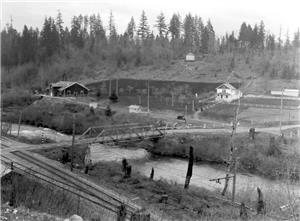Utilizing the Cedar River as Seattle’s watershed was the work of City Engineer R. H. Thomson (1856-1949). In 1899, the City called for bids to create headworks, later named Landsburg, upstream from the town of Maple Valley. This lower gateway to the watershed included a diversion dam, an intake canal, a settling basin, a gatehouse, a horse stable, and a dwelling for the gatekeeper. The contract, won by the Pacific Bridge Company of Portland, Oregon, also called for 28.4 miles of pipeline leading to the Volunteer Park reservoir in Seattle.
Landsburg
The diversion dam was built as a timber crib with concrete abutments, over a foundation of cross sills fixed in the river bottom. The crib was filled with gravel and boulders. The intake canal was redesigned from original plans into a single 54-inch wood stave pipe extending along the south bank of the river to the settling basin.
The 22 x 44 foot settling basin was built of concrete and twisted steel rods. Sluice gates were installed to catch debris and to moderate the flow. A gatehouse was built over the settling basin for use in operation. From the basin, a pipeline ran 13.5 miles to Renton. From Renton, a slightly narrower pipeline carried the water to Seattle.
The dwelling for the gatekeeper was built west of the gatehouse, along with the horse stable. The house was 24 x 42 feet in dimension, and included indoor plumbing -- a luxury worthy of a water department worker at the time. The first gatekeeper at the site was George Landsburg, hence the name of the headworks.
Water Use Grows with Seattle
As the population of Seattle grew, a second pipeline became necessary, which Thomson had already considered during the 1899 construction of the headworks. In 1908, Pipeline Number Two was constructed parallel to the original. In 1911, a flood wiped out part of both pipelines, at a point where they crossed a bridge over the Cedar River. Similar smaller breaks over the next few years exposed the inefficiency of wooden stave pipes.
In 1922, construction began on Pipeline Number Three, made out of riveted steel. At the same time, Lake Youngs, located west of Landsburg, was converted into an additional impounding basin. A concrete aqueduct was built to connect Landsburg and Lake Youngs. This work was completed in 1930.
Updates were made to the now 30-year-old system, so a new screen house was built at Landsburg. Water entering the new water works passed through six trash racks, then through six motorized sluice gates. Finally it was filtered through six mesh screens. From there it followed the aqueduct to Lake Youngs.
A large water tank was built at the same time as the screen house for a pressurized system used to clean the screens. The screens would be lifted out and sprayed, then rotated back into position to provide even wear on both sides. Debris removed by the high-pressure spray would be hauled out.
Sunday in the Park
By this time, the Seattle Water Department was very proud of its modern water system. Tours were often given of the Landsburg site, so the grounds were re-landscaped. Flowers and trees were planted, and railings were built at the water’s edge.
From Renton, green and white signs marked “W. D. Route” (Water Department Route) led motorists to Landsburg. Upon arrival, they could tour the facilities, and then enjoy a leisurely lunch under the trees. A large open area was ideal for croquet, bocce ball, or just plain lolling in the sun.
River Rock
By 1935, the original wooden crib dam was showing its age. It was replaced with a concrete dam. At the same time, further landscaping was done to the site, including the construction of two river rock restrooms, a river rock retaining wall, and a river rock pathway. River rock was used extensively at Landsburg during this period, giving the place a rustic look that remains to this day.
Few exterior changes have been made at the Landsburg buildings in the latter part of the twentieth century. Equipment upgrades and slight remodels were made over the years, but almost all of the buildings remain intact. In the 1980s, a garage, a generator building, a compressor building, and fluoride tanks were added to the site. In the 1990s, a fish hatchery was built along the south bank of the river.

